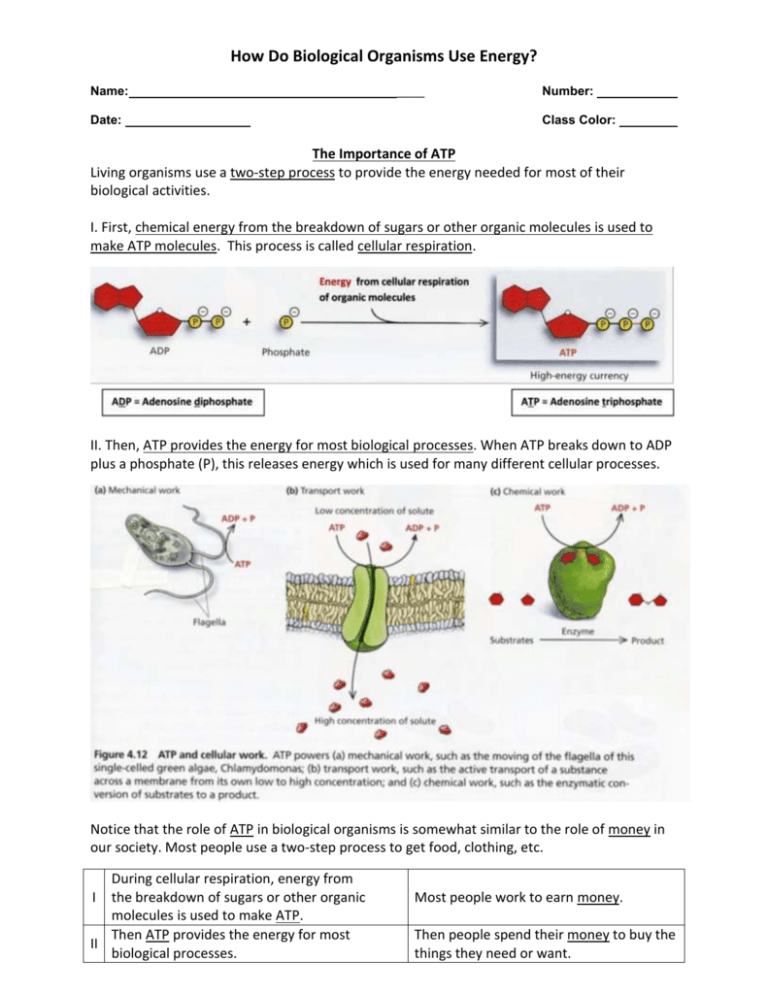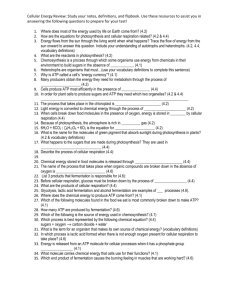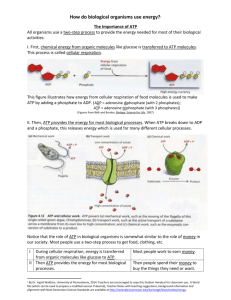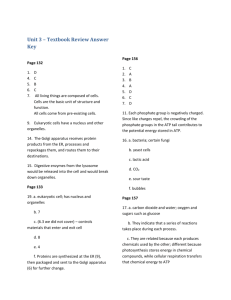How Biological Organisms Use Energy
advertisement

How Do Biological Organisms Use Energy? Name: Date: ____ Number: Class Color: The Importance of ATP Living organisms use a two-step process to provide the energy needed for most of their biological activities. I. First, chemical energy from the breakdown of sugars or other organic molecules is used to make ATP molecules. This process is called cellular respiration. II. Then, ATP provides the energy for most biological processes. When ATP breaks down to ADP plus a phosphate (P), this releases energy which is used for many different cellular processes. Notice that the role of ATP in biological organisms is somewhat similar to the role of money in our society. Most people use a two-step process to get food, clothing, etc. During cellular respiration, energy from the breakdown of sugars or other organic molecules is used to make ATP. Then ATP provides the energy for most II biological processes. I Most people work to earn money. Then people spend their money to buy the things they need or want. 1. Inside each cell, ATP is constantly breaking down to ADP plus P and ATP is constantly being made from ADP plus P. Add to this diagram to show how the breakdown of ATP is useful and how cellular respiration contributes to the production of ATP. Explain why a cell needs to constantly break down ATP and make ATP. 2. Explain why the reaction, ADP + P ATP, requires energy input. (Hint: Review the top figure on the previous page and remember that like charges repel each other.) I. Cellular Respiration During cellular respiration the breakdown of organic molecules such as sugars or fats provides the energy to make ATP molecules. The chemical equations shown below summarize cellular respiration of glucose (a simple sugar). The actual process of cellular respiration in cells requires many steps which are not shown here. 3. Write the names of each of the molecules in these chemical equations. 4. How do our bodies get glucose and other organic molecules for cellular respiration? 5. Why do we need to breathe all day and all night? 2 6. If you search for "cellular respiration equation" on the web, some of the most popular sites give the following equation for cellular respiration of glucose. C6 H12O6 + 6 O2 6 CO2 + 6 H2O + ATP What is wrong with this equation? (Hint: Think about where the atoms in an ATP molecule come from.) II. Using ATP to Provide Energy for Biological Processes The energy released by the breakdown of ATP to ADP plus P is used for many biological processes, including synthesizing molecules, pumping ions into or out of the cell, and muscle contraction. 7. Fill in the blanks to summarize how ATP provides the energy for muscle cells to contract. many ______ many ______ + many P \/ \/ \/ muscle cells relaxed muscle cells contracted 8. The reaction, ATP ADP + P occurs: a. only in muscle cells b. in muscle cells and nerve cells c. in all the cells in your body. Explain your reasoning to choose the correct answer. Two important general principles about energy are: Energy can be transformed from one type to another (e.g. the stored chemical energy in ATP can be transformed to the kinetic energy of muscle motion). However, energy can not be created or destroyed by biological processes. All types of energy conversion are inefficient and result in the production of heat. For example, when ATP provides the energy for muscle contraction, only about 20-25% of the chemical energy released from the ATP molecules is captured in the kinetic energy of muscle contraction. The rest of the energy from the ATP is converted to heat. 9. Some textbooks claim that "Cellular respiration makes the energy needed for biological processes." Explain what is wrong with this sentence and give a more accurate sentence. 10. Explain why your body gets warmer when you are physically active. 3









